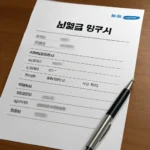Wondering how to navigate the 4th generation transition to loss insurance? Curious about the steps to convert or the duty of notification? This guide covers all you need to know to make informed decisions.
How to Convert 4th Generation Loss Insurance
The 4th generation loss insurance is designed to offer better coverage and lower premiums, reflecting the evolving needs of policyholders. Transitioning to this new insurance model involves a process that can significantly impact your financial planning. In this section, we’ll explore the essential steps involved in converting your existing insurance to the 4th generation model, ensuring that you are fully informed before making any changes.
-
Review Your Current Insurance Plan
Begin by assessing your existing insurance coverage. Understanding what is covered and what isn’t will help you evaluate how the 4th generation plan can better serve your needs. -
Understand the Benefits of Transition
The 4th generation loss insurance offers more flexible options and lower rates. It is designed to respond more efficiently to the rising costs of healthcare and other relevant risks. This is a crucial factor to consider when deciding to convert. -
Research Available Providers
Different insurance companies may offer varying levels of coverage under the 4th generation loss insurance plan. Comparing providers and their offers can ensure you select one that best meets your needs. -
Consult an Insurance Expert
Given the complexity of insurance policies, speaking with an insurance advisor can help clarify your options. They can guide you through the conversion process and help tailor the insurance to your unique situation. -
Submit the Required Documentation
Insurance providers will often require specific documents for conversion, such as your current insurance policy details and identification. Ensure that you have all necessary paperwork ready. -
Evaluate the New Premiums
Before finalizing your decision, take a close look at the new premiums. While 4th generation plans are generally more affordable, it’s important to ensure they align with your budget and coverage needs. -
Complete the Conversion Process
Once you’ve selected your new policy, follow the provider’s instructions to complete the transition. This may include signing new agreements and confirming the start date of the new coverage.
To learn more about the conversion process and compare insurance plans, click the link below.
Duty for Notification of 4th Generation Transition to Loss Insurance
One of the often overlooked aspects of transitioning to the 4th generation loss insurance is the legal responsibility for notification. As policyholders, it is crucial to understand who is responsible for notifying the transition and the timelines involved. This ensures that you comply with regulations and don’t face any unexpected issues with your coverage.
-
Know Who Must Notify
Generally, the insurance provider is responsible for notifying policyholders about the transition to the 4th generation insurance model. However, in some cases, it may be your responsibility as the policyholder to initiate the process of conversion. -
Understand the Notification Timeline
Insurance companies typically provide a notification period, which can vary. Ensure that you act within this window to avoid any lapses in coverage or missed opportunities to transition. -
Keep Track of Communications
It is essential to keep a record of all notifications from your insurer. This includes emails, letters, or any official documents related to the transition. Keeping these records will help avoid confusion or disputes in the future. -
What to Do if You Miss the Deadline
If you fail to notify the insurer within the required timeframe, you may face penalties or delayed coverage. In some cases, it may be possible to still transition after the deadline, but this typically involves additional steps and fees. -
Mandatory Notifications for Certain Policyholders
In certain situations, such as when there are significant changes in the policy or regulations, insurance companies are legally bound to notify policyholders of the transition. Ensure you are aware of these situations to avoid any surprises.
To understand more about the notification duties and timelines, click the link below.
👉 Learn About Notification Duties 👈
4th Generation Loss Insurance Comparison
As you consider the 4th generation loss insurance, it is helpful to compare it against previous generations to understand its advantages and limitations. By understanding the differences, you can make an informed decision about whether this new insurance model is right for you.
-
Premiums
The most notable difference between the 4th generation and earlier models is the premium structure. Typically, the 4th generation model offers lower premiums, especially for younger policyholders, while still maintaining comprehensive coverage. -
Coverage Scope
The 4th generation loss insurance generally includes broader coverage. This can include more extensive healthcare services and added benefits like protection against new types of risks, which were not covered in older plans. -
Flexibility and Customization
One of the most praised features of the 4th generation model is its flexibility. Unlike previous generations, the 4th generation insurance allows for more customization of the coverage, enabling policyholders to adjust it based on their needs. -
Claims Process Efficiency
With the introduction of digital platforms, the 4th generation insurance model has streamlined the claims process. Claims can be processed faster, reducing the overall time needed to receive reimbursements. -
Policyholder Benefits
The new policies often come with additional benefits, including wellness programs, discounts for healthy behaviors, and better customer service, all of which enhance the overall policyholder experience. -
Duration of Coverage
4th generation insurance plans tend to offer longer-term coverage compared to earlier models. This means fewer renewals are required, providing peace of mind for policyholders.
To see a side-by-side comparison of the 4th generation loss insurance plans, click the link below.
Conclusion
The transition to 4th generation loss insurance offers a range of benefits, including more affordable premiums, better coverage, and enhanced flexibility. However, it’s crucial to understand the steps involved in converting, the duty of notification, and how it compares to previous insurance models. By following the proper procedures and doing your research, you can ensure that your transition goes smoothly and that you choose the best coverage for your needs.
As insurance continues to evolve, staying informed about your options will help you make the best decisions for your financial future. Whether you’re looking to reduce premiums, expand coverage, or streamline your claims process, the 4th generation loss insurance model offers solutions for all.
“The future belongs to those who prepare for it today.” – Malcolm X






